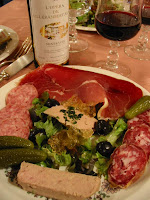Bread is the most consumed staple food in France. It is present at every meal, and it takes your cultural and culinary experiences to new heights.
The most recognizable form of French bread is the baguette, which is long and narrow, between 2-3' in length and 3-5" in thickness. Actual French law dictates that the baguette de tradition française should contain only combinations of wheat flour, water, yeast and common salt.
In addition to the baguette, you find a slimmer version called a ficelle (string), and a wider version called a flûte. There are round loaves called boules (which is "ball" in French) and rugby ball shaped loaves called bâtard (literally "bastard"). The list goes on from there, to include bread in the form of a ring, braided breads, and various other artisan breads. And of course, let's not forget the coissants. Flaky, light, buttery...and my favorite kind: croissant d'amande.
Breakfast in France often consists of baguette from the night before, sliced lengthwise and spread with butter and jam. The tartine is then dipped in a frothy bowl of café au lait or chocolat. For most French people, dipping day-old bread in a hot beverage is the only acceptable way to eat it. For lunch and dinner, however, fresh-baked bread is a must.
Every morning, French people visit (usually on foot) their neighborhood boulangerie. Enough bread is purchased for the main meals of the day, and for breakfast the next morning. Buying bread was one of my favorite daily adventures when I lived in France. The boulanger knew all his customers by name. Locals took their time, chatting with him and each other, with no sense of urgency to move on to the next task of the day. I felt embraced by the French on those outings!
In the United States, we serve our bread with butter. Not so in France. Instead of an accompaniment, bread is used as an utensil. You tear a piece of your morsel and hold it in your free hand, using it to push food onto the prongs of your fork and sop up the silky sauces. And you may not see this in restaurants, but at my in-laws' house you can tell when everyone is finished eating: every plate has been wiped clean, every drop of sauce consumed along with the bread.
Throughout the day, people stop into the boulangerie for a cup of coffee and a light snack.
Many boulangeries are also patisseries -- where French pastries are sold.
My absolute favorites are the tartes de flan. To die for!
And, 'cause I mentioned them earlier: Coissant d'amande -- YUM!
Leave me a comment and earn one entry in my Vive la France! Contest.






















































